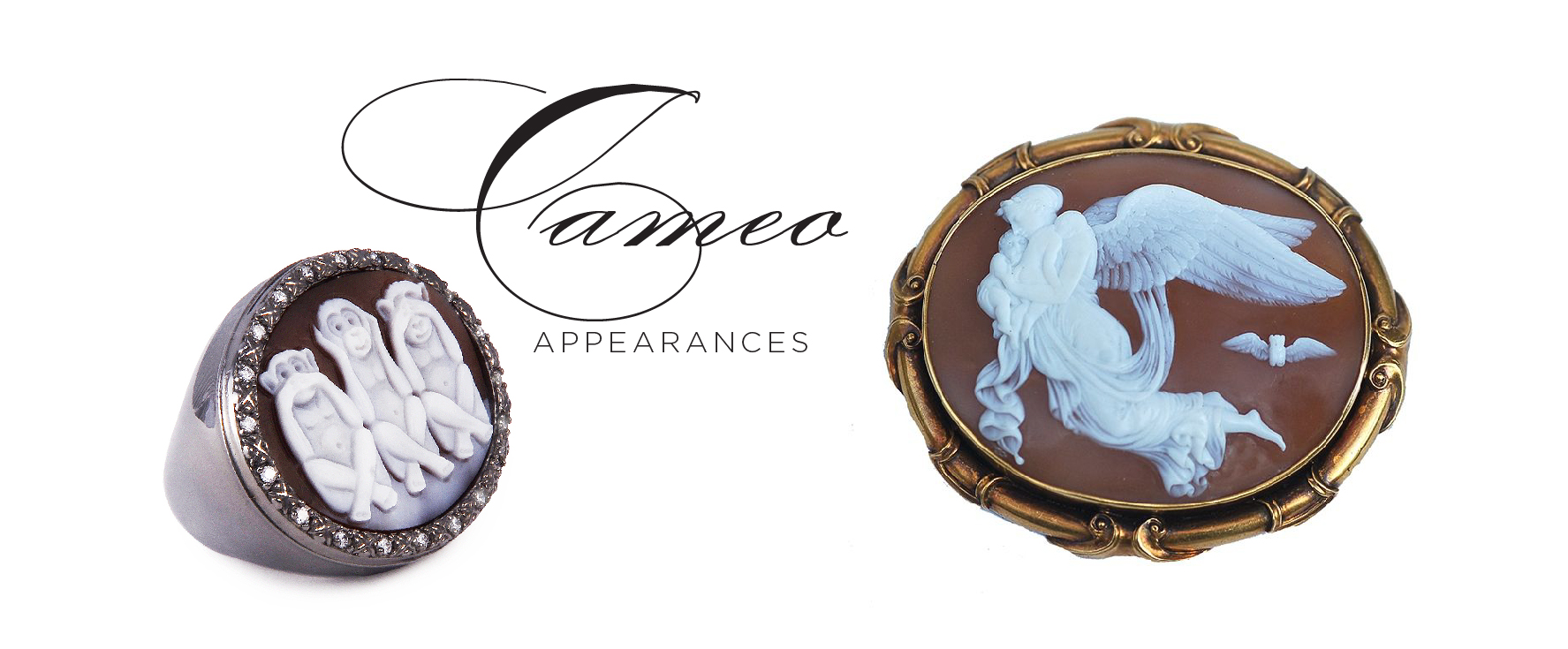The new role of Cameos the jewelry scene.


Rowan & Rowan’s Bull’s Mouth shell cameo in a gold repousse mount, circa 1860. The subject is ‘Night’, based on a bas-relief by Bertel Thorvaslden, Rome, early 19th century. The goddess Nyx [Night] floats through the night sky, cradling in her arms her two children, Hypnos [Sleep] and Thanatos [Death].

Berganza Victoria shell cameo dem-parure
In a time when antique jewelry continues to show up on modern ready-to-wear runways and renowned auction houses are targeting a new generation of customers, certain period jewels are witnessing a resurgence. Such is the case of the cameo’s appearance on the jewelry scene.
Cameos that date back for centuries are seeing a revival among novice and avid antique jewelry collectors. They are also getting a makeover in the hands of current designers such as Amedeo, who creates bold, ultra hip, often tongue-in-cheek renditions of these miniature scenes and motifs from history.
Michele Rowan, a renowned London-based antique jewelry dealer and the author of Nineteenth Century Cameos, explains “this resurgence can be attributed to the fact that a well-carved cameo is a miniature sculpture, a work of art. In this age when jewelry can be produced by laser printers, a cameo that took approximately a year to carve by hand has reason to be admired and added to one’s collection,” she adds. “There is also the enduring appeal of the subject matter of these jewels. Cameos depicted stories, mainly based on ancient mythology. The power and fascination of those myths remain. Tales of love, loss, betrayal and heroic deeds are as intriguing today as they were in ancient times.”

S.J. Phillip’s 19th century gold, enamel and gem set cameo brooch by Ernesto Pierret, Italian c.1860
In addition to the allure of ancient and antique cameos, Amedeo Scognamiglio launched his collection in 2006 based on old world carving techniques, which he learned when he was 16 years old while working for his father’s company, M+M SCOGNAMIGLIO. “I wanted to bring back this historical and artistic tradition but with a contemporary hand, reimagining the classical into pieces that had a modernity and sense of humor,” he says. Cameos, which are carved in relief in hard stone, shell and lava, have been created since the early 1800s in Amedeo’s hometown of Torre del Greco, Italy.

Amedeo hear no evil, speak no evil, see no evil monkey cameos
Although cameos date back to the days of Alexander the Great, they were popular through many periods and centuries. The earlier examples are usually found in museums, such as the onyx cameo depicting Aesop’s Fable, the Dog and the Shadow, which was part of London’s Cheapside Hoard and is now housed in the Museum of London.

Aesop’s Fable Cameo fromThe Cheapside Hoard: Londons Lost Jewels
Rare examples that can be found outside of exhibitions and permanent collections include cameos crafted during the Victorian era. Rowan explains, “During the 19th century visitors on the Grand Tour to Italy purchased cameos based on famous sculptures and other works of art as souvenirs of their travels. Hand carved from shell, agate or coral, these pieces were worn, treasured and passed down through generations.”

It wasn’t until the mid-20th century that cameos began to receive a bad rep due to machine carving, poor quality and uninspiring motifs.
A few noteworthy designers and design studios in Torre del Greco brought cameos back in the late 1990s but none had the captivating effect or inventiveness of the Amedeo pieces—those that depict the hear no evil, see no evil, speak no evil monkeys, the tattoo-inspired snakes or the classical cupids, crowns and double hearts that are set in chunky, rocker style rings and bracelets, with colored gemstone and diamond pave´.
- Amedeo’s cupid ringwih enameling and gemstones
- Amedeo’s spider and butterfly ring
Cameos, like other forms of jewelry—brooches for example—are not for everyone. But for those who love a piece of history, tales of gods and goddesses and the lure of lore and legend, antique cameos can be personalized by wearing them with modern designer styles or surrounded by a dash of color. Or you can purchase Amadeo’s contemporary wink to the classics.
- Yvonne Look of @Luckandlockets on instagram wears her agate cameo with old cut diamond surrond with a Karen Karch ring
- Anabel Higgins updates a classical shell Victorian cameo with turquoise cabochon surround
Whichever you choose, Rowan gives some advice on buying them. “Only purchase the best example you can afford in antique cameo. Hold it up to the light and make sure the shell or hard stone is not cracked. And most of all, only buy a cameo that you believe you will wear –one that makes your heart skip a beat and that you cannot stop thinking about until you possess it.”








